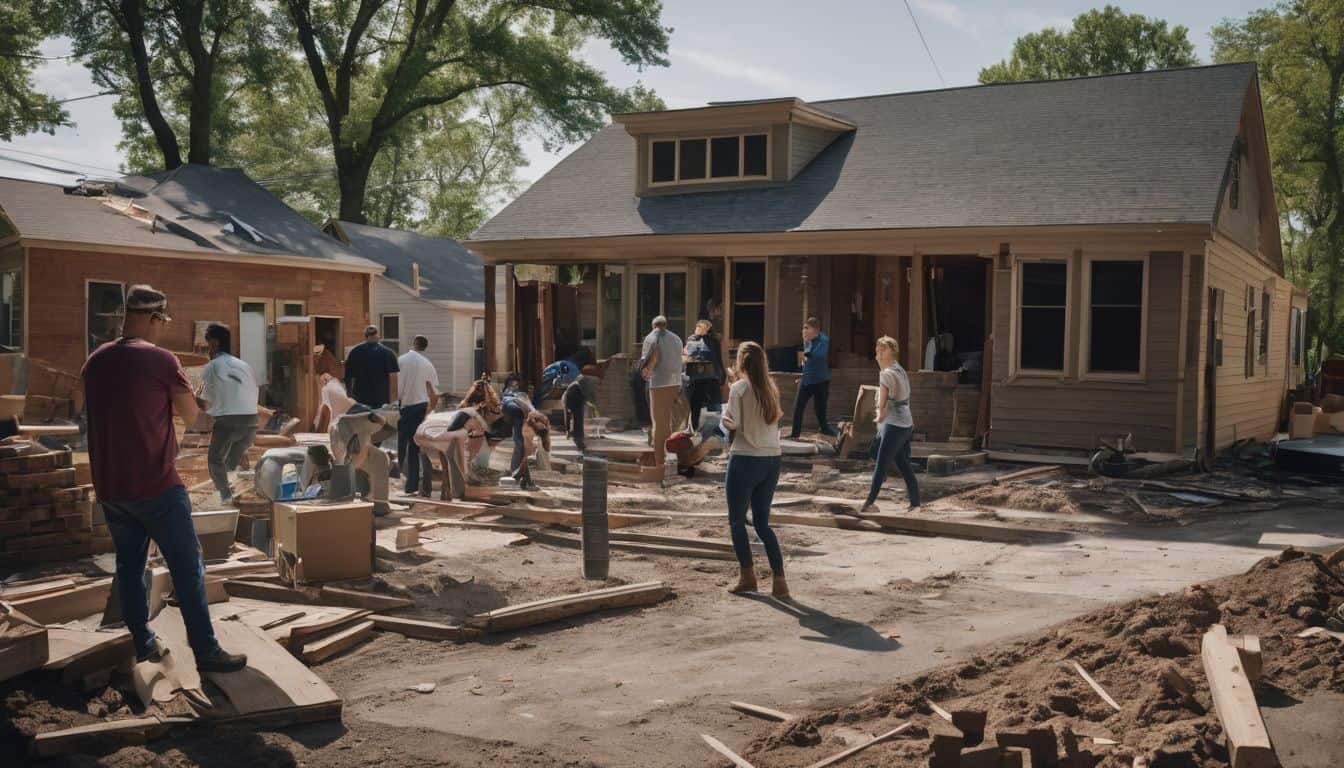Ever found yourself daydreaming about how to effectively signal for help in an emergency? We’ve had those thoughts too, and we realized it’s a critical survival skill that isn’t given as much attention as it should be.
Armed with research and hands-on knowledge, this article will walk you through seven reliable techniques of emergency signaling — from easy-to-remember visual signals to handy communication devices.
Buckle up, fellow survival enthusiasts: these pointers could make the difference between danger and safety!
Key Takeaways
- Emergency signaling techniques play a crucial role in ensuring safety and survival during emergencies.
- Visual signals like fire, smoke, and flares can attract attention over long distances.
- Audible signals like whistles and sirens are reliable methods for short-range signaling.
- Communication devices such as cell phones, radios, and emergency communication systems are essential tools for staying connected and getting help during emergencies.
The Importance of Emergency Signaling
Emergency signaling is of utmost importance as it plays a crucial role in ensuring safety and survival during emergencies.
Being prepared for emergencies
I always keep my gear ready for any sudden bad times. I have an action plan in place. It is very useful to stay calm and act fast in emergencies. This is a strong part of being safe during such hard times.
Studies show that if we know what to do, we have a better chance to stay safe in real emergencies. Being ready and knowing what steps to take can make a big difference. It’s not only about keeping ourselves safe, but also helping others when they need it the most.
Ensuring safety and survival
In any emergency, safety and survival are top priorities. I make sure to have an emergency signaling plan ready. This is key for my protection during tough times. It helps me get the help I need fast.
Effective emergency messages play a big role too. They can keep people safe and save property from harm. But talking during a natural disaster can be hard! That’s why it’s vital for me to set up reliable communication methods ahead of time.
I don’t rely on just one way to send out signals in an emergency case though! Instead, using well-practiced signaling techniques boosts my ability to get attention when needed most! These tools aid not only in securing personal safety but also in coordinating response efforts across teams and groups.
Cooperation and readiness are crucial for achieving success amidst chaos.
Different Methods of Signaling
There are various methods of signaling in emergency situations, including passive and active techniques, as well as day and night signaling methods.
Passive and active signaling techniques
In an emergency, you can send signals in two ways. These are passive and active signaling techniques. For passive signs, you don’t need extra energy. You set up a sign and let it do its work on its own.
An SOS made from rocks is one such sign. Active signs need you to put in some power or effort. Lighting flares, using radios or sending out loud shouts are active techniques of passing your message across in dire situations.
Both types hold their merit depending on the situation at hand.
Day and night signaling methods
During emergencies, it’s important to have signaling methods that work both during the day and at night. Visual distress signals like flares and other lighting devices can be used to attract attention in any lighting condition.
Hand-held red flares are effective for both day and night emergencies, while electric distress lights are suitable for nighttime use. These visual signals rely on sight and can transmit prearranged messages over short distances.
For boating emergencies, there are specific visual distress signals designed for different lighting conditions, including day signals, night signals, and anytime signals. Having these signaling methods ready can help ensure your safety and increase your chances of being found during an emergency situation.
Near and far signaling methods
In emergency situations, it’s important to know how to signal for help. There are different methods you can use, depending on whether you need to be seen from a near distance or a far distance.
For near signaling methods, you can create visual signals like fires, smoke, or flares. These can easily catch someone’s attention if they’re close by. For far signaling methods, you can use audible signals like whistles or sirens.
These sounds can travel further and alert people that you need help. It’s crucial to understand these techniques so that you can increase your chances of being found and rescued in an emergency situation.
Visual signals (fire, smoke, flares)
Visual signals, like fire, smoke, and flares, are essential tools for emergency signaling. They can help convey distress and attract attention over long distances. Here are some key points to remember about visual signals:
- Fire: Building a fire is an effective way to signal for help, especially in darkness. The flames and smoke are visible from far away, making it easier for rescuers to locate you.
- Smoke: Creating a column of smoke can also be a useful visual signal. You can achieve this by burning green vegetation or using wet materials to produce thick white smoke. Make sure you choose a location where the smoke will be clearly visible.
- Flares: Flares are specially designed signaling devices that emit bright light and sometimes accompanied by loud bangs. They are commonly used at sea but can also be effective on land. Flares have advantages due to their high visibility but should only be used when you’re certain help is nearby because they have limited burn times.

Audible signals (whistles, sirens)
When it comes to emergency signaling, audible signals like whistles and sirens can be incredibly valuable. Here are some important points to know about these methods:
- Whistles are reliable and effective for short – range signaling. They produce a loud, piercing sound that can be heard from a distance.
- Sirens, on the other hand, are considered one of the best emergency signaling methods. They provide a louder and attention-grabbing alert compared to whistles.
- In emergency situations, sirens are commonly used by emergency vehicles to navigate through traffic more effectively and safely.
- It’s worth noting that the usage of sirens may vary among different communities in emergency situations.
Communication devices (cell phones, radios)
Communication devices such as cell phones and radios are crucial tools in emergency situations. They help us stay connected and communicate with others for assistance. Here are some important communication devices to consider:
- Cell phones: These portable devices allow us to make calls, send text messages, and access the internet. They rely on mobile phone networks to establish communication.
- Two-way radios: Also known as walkie-talkies, two-way radios are handheld devices that enable direct communication between two or more individuals within a specific range. They are useful in remote areas where cell phone reception may be limited.
- Emergency communication systems: These systems are specifically designed for emergency situations. They often include features like panic buttons or pre-programmed emergency numbers for quick access to help.
- Smartphone apps: Many apps offer emergency alert features, allowing users to send distress signals or notifications directly from their smartphones. Some apps even provide real-time location tracking for added safety.
- Telecommunication devices: These include landline telephones or VoIP (Voice over Internet Protocol) phones that operate through an internet connection. They provide a reliable means of communication during emergencies when other methods may fail.
- Public safety radios: Used by first responders and emergency personnel, these radios ensure effective and secure communication within the public safety network. They often have robust features like encryption and priority channels.
- Emergency alert systems: These systems broadcast alerts through various channels, such as television, radio, sirens, or text messages. They notify the public about imminent dangers or required actions during emergencies.
Establishing a Communication Plan
In an emergency, it is crucial to have a communication plan in place beforehand. Key stakeholders should be identified, and multiple methods of communication should be used to ensure that everyone is informed and updated regularly.
Creating a plan before an emergency
Before an emergency occurs, it is essential to have a plan in place. This will help ensure effective communication during a crisis. Here are some key steps to consider when creating your emergency communication plan:
- Identify key stakeholders: Determine who needs to be included in your communication plan, such as family members, neighbors, or coworkers.
- Establish multiple methods of communication: Utilize different channels like phone calls, text messages, emails, and social media platforms to reach out to people during an emergency.
- Provide frequent updates: Regularly share information with your contact list about the situation and any necessary actions they need to take.
- Include important details: Make sure to include relevant information like meeting locations, evacuation routes, and emergency contact numbers in your plan.
- Practice the plan: Conduct drills and practice scenarios with your family or team so everyone knows what to do in case of an emergency.
Identifying key stakeholders
When it comes to emergency signaling, it’s important to establish a communication plan and identify key stakeholders. Stakeholders are individuals or groups who have an interest or involvement in the emergency response.
They can include first responders, government agencies, community organizations, and even members of the public. By identifying these stakeholders early on, we can ensure that everyone is on the same page and that information is communicated effectively during emergencies.
This helps us coordinate our efforts and provide timely updates to those who need it most. So remember, when planning for emergency signaling techniques, don’t forget to identify your key stakeholders for a successful communication strategy.
Using multiple methods of communication
During an emergency, it’s crucial to have multiple ways to communicate. This ensures that you can reach out for help and stay informed about the situation. By using diverse communication methods like cell phones, radios, or even social media platforms, you can increase your chances of getting a signal through.
It’s also important to establish a communication plan beforehand and identify key stakeholders who need to be kept in the loop during an emergency. Providing frequent updates and utilizing different methods of communication will help ensure that your messages are received and understood by those who need them most.
Remember, when it comes to emergencies, effective communication can make all the difference in ensuring your safety and survival.
Providing frequent updates
In any emergency situation, providing frequent updates is incredibly important. It helps to keep everyone informed and ensures that the right actions are taken. Regular communication is key during a crisis, as it allows for timely updates and enables effective crisis management.
By engaging with stakeholders and sharing relevant information through different communication channels, we can overcome the challenges of communicating in high-pressure situations.
With accurate and up-to-date information exchange, we can work together to respond swiftly and effectively to any emergency or disaster.
Training and Education
Training and education are key for mastering emergency signaling techniques.
Educating individuals on signaling techniques
I believe that educating individuals on signaling techniques is crucial for their preparedness and survival during emergencies. By learning different methods of signaling, individuals can effectively communicate their distress and increase their chances of being found.
It is important to practice and become familiar with these techniques so that they can be used efficiently in high-stress situations. In addition to visual signals like fire, smoke, or flares, it is also vital to understand the use of audible signals such as whistles or sirens.
Communication devices like cell phones or radios should be included in emergency kits as well. By providing training and education on signaling techniques, we empower individuals to take responsibility for their safety and improve their chances of getting help when needed.
Practicing and becoming familiar with different methods
Practicing and becoming familiar with different methods is crucial when it comes to emergency signaling techniques. Here are some important methods to consider:
- Learn about passive and active signaling techniques – Passive techniques include creating signals that can be seen from a distance, like building a fire or using mirrors to reflect sunlight. Active techniques involve making noise or using devices that emit light, such as whistles or flares.
- Understand day and night signaling methods – Different signaling methods may be needed depending on the time of day. During the day, you can use bright colors or flags to attract attention. At night, using flashlights or glow sticks can help make your signals visible.
- Know about near and far signaling methods – Depending on the situation, you might need to signal for help to people who are nearby or those who are far away. For close-range signals, hand signals or waving can be effective. For long-range signals, using tools like whistles or even a signal mirror can increase your chances of being seen or heard.
- Familiarize yourself with visual signals – Visual signals like fire and smoke can be effective in attracting attention during the day. Carrying flares in your emergency kit can also be useful in making yourself visible to rescuers.
- Consider audible signals – In situations where visibility is limited, using audible signals like whistles or sirens can help alert others to your presence.
- Explore communication devices – Having communication devices like cell phones or radios in your emergency kit can provide more options for reaching out for help when needed.
- Practice regularly – The more you practice these different methods of signaling, the more comfortable and confident you will become in using them during an actual emergency situation.
Emergency Signaling Techniques: 7 Ways to Success
Emergency signaling techniques are essential for successful emergency action plans. As a survival enthusiast, here are 7 ways to ensure success in emergency signaling:
- Use visual signals: Set up fires, create smoke, or use flares to attract attention.
- Make audible signals: Carry a whistle or siren to create loud sounds that can be heard from far away.
- Have communication devices: Keep cell phones and radios handy to call for help and stay connected with others.
- Establish a communication plan: Before an emergency happens, create a plan with key stakeholders and use multiple methods of communication.
- Train and educate yourself: Learn different signaling techniques and practice them so you become familiar with their use.
- Carry essential signaling tools: Always have whistles and flares on hand as they can be lifesavers in emergencies.
- Utilize technology: GPS devices and satellite phones can be helpful in getting accurate location information and contacting rescuers.
Equipment and Tools
Carry essential signaling tools like whistles and flares, and make use of technology such as GPS devices and satellite phones.
Carrying essential signaling tools (whistles, flares)
Carrying essential signaling tools is crucial for emergency situations. Here are some important tools that you should include in your survival kit:
- Whistle: A whistle is a simple and effective signaling tool. It can be heard from a distance, even in noisy environments. Make sure to choose a whistle that is loud and durable.
- Flares: Flares are a must-have for emergency signaling. They produce bright, colorful lights that can be seen from far away, especially at night. Store flares properly to ensure they remain in good condition.
- Signal mirror: A signal mirror can help you reflect sunlight towards potential rescuers, increasing your chances of being spotted from afar. It’s lightweight and easy to carry.
- Glow sticks: Glow sticks are useful for signaling during nighttime emergencies. They emit a bright light that can be seen in the dark, making them ideal for attracting attention.
- Personal locator beacon (PLB): A PLB is an advanced signaling device that uses satellite technology to transmit distress signals to rescue authorities. It provides your exact location, ensuring swift response during emergencies.
Using technology (GPS devices, satellite phones)
I believe that using technology can greatly enhance our emergency signaling efforts. Here are some ways that GPS devices and satellite phones can be invaluable in survival situations:
- GPS devices: These handy gadgets provide us with accurate navigation and location tracking. With a GPS receiver, we can determine our exact coordinates, ensuring that we stay on the right path and avoid getting lost.
- Satellite phones: In remote areas where regular cell phone coverage is unavailable, satellite phones come to the rescue. They use satellites orbiting the Earth to transmit conversations and data, allowing us to communicate with rescue teams or loved ones during emergencies.
- Emergency response: By using GPS technology, emergency responders can quickly locate people in distress and provide timely assistance. This can be crucial in situations where every second counts, such as natural disasters or accidents.
- Communication technology: Social media, mobile applications, landline telephones, and even cell phones play a vital role in emergency communication. They allow us to connect with authorities, share information about our situation, and receive updates on rescue operations.
Creating a Sense of Urgency
Creating a sense of urgency is crucial in emergency situations, as it motivates individuals to take immediate action and prioritize the signal for help.
Understanding the importance of urgency
Creating a sense of urgency is crucial in emergency signaling techniques. When faced with a crisis, time is of the essence and urgent action must be taken. It’s important to recognize that emergencies require immediate and rapid responses.
Every second counts when it comes to safety and survival. Therefore, having a sense of emergency ensures timely communication, swift actions, and a pressing need to address the situation at hand.
Urgency should be ingrained into our mindset before an emergency arises so that we can act quickly and effectively when it matters most.
Building a culture of urgency
Building a culture of urgency is crucial when it comes to emergency signaling. It means understanding the importance of acting swiftly and efficiently in times of crisis. As a survival enthusiast, I know that being proactive and prompt can make all the difference in ensuring safety and survival.
To create this sense of urgency, leaders must model urgent behaviors themselves and empower their team members to deliver. Rewarding incremental successes can also help increase the overall sense of urgency within the group.
By building this culture, we can be prepared to respond quickly and effectively in any emergency situation.
Making urgency personal
Building a culture of urgency is crucial when it comes to emergency signaling. It’s about making urgency personal and internalizing its importance. By understanding the time sensitivity of emergencies, I can develop a proactive mindset and accelerate progress in critical situations.
This urgent mindset motivates me to act swiftly, make prompt decisions, and enhance efficiency in my emergency signaling techniques. By modeling urgent behaviors and staying with my team, I can create a sense of urgency that enhances our ability to survive and ensure safety in any emergency situation.
Modeling urgent behaviors
Building a culture of urgency is crucial in emergency situations. It’s important for individuals to model unruffled but urgent behaviors openly and often. This encourages others to take quick action when it matters most.
Successful marketing strategies also rely on creating a sense of urgency to drive conversions. By changing the way target audiences behave, businesses can effectively communicate the importance and immediacy of their products or services.
Leaders should lead by example and demonstrate the behavior they want their team to exhibit during emergencies. By showing a sense of urgency themselves, leaders empower employees to act swiftly and decisively.
Empowering employees to deliver
Empowering employees is a crucial aspect of creating a culture of urgency in emergency signaling techniques. When we empower our employees, we give them the tools and support they need to deliver on their responsibilities effectively.
It means motivating them, building a strong team culture, and fostering proactive behavior. By nurturing a sense of responsibility and promoting a growth mindset, employees are encouraged to take ownership of their tasks and make informed decisions.
We also provide continuous learning opportunities and develop effective communication skills so that employees can confidently respond to emergencies. Ultimately, empowering our employees allows them to contribute their skills and expertise towards achieving success in emergency signaling techniques.
Staying with your team
In any emergency situation, staying with your team is crucial for ensuring everyone’s safety and increasing the chances of survival. By staying together, you can provide support to one another, share resources, and work towards a common goal.
Team cohesion is essential in maintaining motivation and effective leadership during challenging times. It also allows for better communication and coordination among team members.
Additionally, by sticking together, you can hold each other accountable and help manage time effectively. Adaptability becomes easier when everyone is on the same page and committed to the goal at hand.
Considerations for Specific Environments
Signaling in wilderness or rural areas can be challenging due to limited resources and potential geographical obstacles. In urban areas, there may be more opportunities for visual signals such as waving flags or flashing lights.
Signaling on water requires specialized equipment like marine distress signals. To learn more about these specific environments and how to effectively signal for help, continue reading the full blog post.
Signaling in wilderness or rural areas
When you find yourself in a wilderness or rural area, signaling for help is crucial to ensure your safety and survival. Here are some important considerations for effective emergency signaling:.
Firstly, it’s essential to have the right tools with you. Make sure to pack a whistle as it is a widely recognized distress signal in the wilderness. Three blows of a whistle can alert others that you’re in need of help.
Additionally, carrying a signaling device like an emergency beacon can greatly increase your chances of being found. There are different types available, such as EPIRBs for maritime use and PLBs for wilderness use.
These devices transmit distress signals to search and rescue teams.
Signaling in urban areas
Signaling in urban areas is a critical aspect of emergency preparedness. In these environments, it’s important to have effective communication strategies to ensure that your signals are visible and reach the intended recipients.
When signaling in urban areas, it’s essential to establish a communication plan beforehand. This includes identifying key stakeholders and using multiple methods of communication such as visual signals like fire or flares, audible signals like sirens or whistles, and communication devices like cell phones or radios.
It’s also crucial to consider both daytime and nighttime signaling methods to ensure visibility during different conditions. Additionally, near and far signaling methods should be used to reach individuals at various distances within urban areas.
Signaling on water
When signaling on water, it’s important to follow safety regulations and use the right marine distress signals. In international waters and territorial seas, boats are required to have visual distress signals for coastal navigation.
Good judgment is crucial when using these signals for emergencies. It’s also worth noting that non-pyrotechnic visual distress signals can operate for a long time during an emergency.
Additionally, VHF radio is commonly used for safety and distress communication in the United States, so having one on board can be helpful. Remember, using USCG approved visual distress signals ensures you meet safety requirements while out on the water.
The Importance of Being Found
Being found in an emergency situation is crucial for ensuring safety and survival. It is important to take responsibility for being found and avoid relying solely on phones, as they may not always be reliable in such situations.
Taking responsibility for being found
When it comes to emergency situations, taking responsibility for being found is crucial. It means being proactive and doing everything possible to ensure that rescuers can locate you quickly.
One important aspect of taking responsibility is not relying solely on phones in emergencies. While cell phones can be useful, they are not always reliable due to limited battery life or lack of signal in remote areas.
Instead, consider using other signaling techniques like visual signals (such as fire or smoke), audible signals (like whistles), or carrying essential signaling tools like flares. By being prepared and actively taking part in your own rescue efforts, you increase the chances of being found quickly and safely.
Avoiding reliance on phones in emergencies
In emergencies, it’s important to have a backup plan in case your phone isn’t available. One way to avoid relying solely on phones is by using satellite phones, which work even when there are no land-based towers or networks.
They can be more useful in emergency situations because they provide reliable communication options. Additionally, mobile devices and apps are also helpful tools that can save critical time for healthcare professionals during emergencies.
By exploring alternative communication methods and being prepared with the right tools, we can improve our chances of staying connected and getting the help we need when it matters most.
Conclusion on Emergency Signaling Techniques
In conclusion, emergency signaling techniques are essential for ensuring safety and survival in emergencies. By following the seven ways to success discussed in this article, including establishing a communication plan, training and education, and using the right equipment and tools, individuals can increase their chances of being found quickly in an emergency situation.
Remember that effective communication and preparedness are key to successfully signaling for help when it matters most. Stay safe!
FAQs on Emergency Signaling Techniques
1. What are emergency signaling techniques?
Emergency signaling techniques are methods or ways to communicate for help in a dangerous situation, such as using signals or sounds to attract attention.
2. What are some common emergency signaling techniques?
Some common emergency signaling techniques include using a whistle, making loud noises like banging pots and pans together, using a mirror to reflect sunlight, or creating smoke from a fire.
3. How do I choose the right emergency signaling technique?
The choice of an emergency signaling technique depends on the situation and resources available. Assess your surroundings and choose a method that is easily noticeable and can be understood by others who may respond to your distress signal.
4. Can I use my cell phone as an emergency signal?
Yes, if you have cellphone service or Wi-Fi connectivity, you can use your phone to call for help or send text messages with your location information. In areas without reception, it’s important to rely on other non-electronic signaling methods.
5. Are there any universal signals for emergencies?
While there are no universal signals recognized worldwide, commonly known distress signals include waving both arms in the air, SOS spelled out with rocks or branches on the ground, or shouting “Help!” loudly and repeatedly when someone is nearby.





Leave a Reply